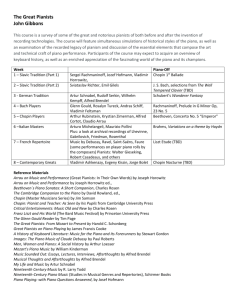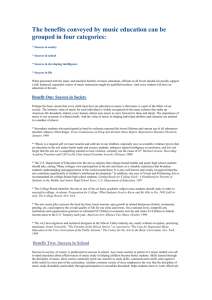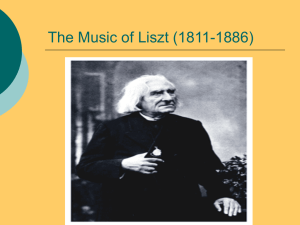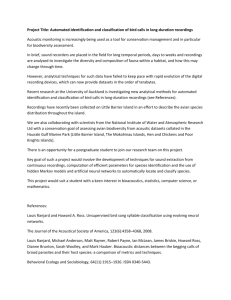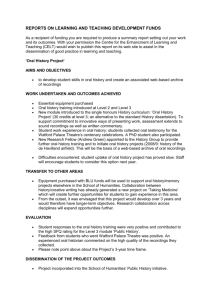CD track listings and sample biographies
advertisement
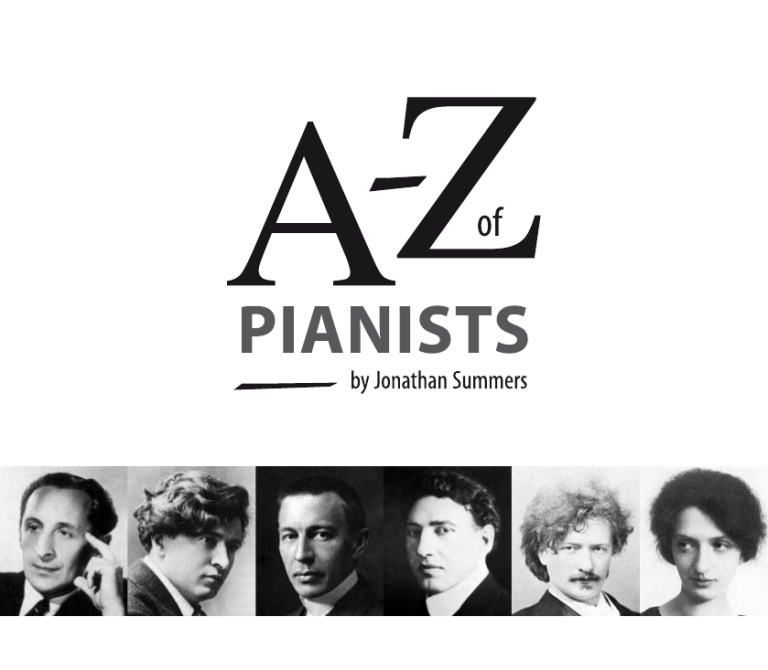
of PIANISTS PREFACE This book is intended to provide guidance for anyone wishing to purchase recordings of pianists on compact disc. Its format is alphabetical, with each entry consisting of a biography followed by comment on the recordings of the pianist concerned. Where an important recording has not been reissued on compact disc I have referred to the original LP. The career list is intended to outline the pianist’s life at a glance by noting salient points. Biographical information is only as good as the source from which it is gleaned and in many cases conflicting evidence has been discovered: for example the date of birth of Gina Bachauer is given variously as 1910 and 1913, that of Felicja Blumental as 1908, 1911 and 1918, and Shura Cherkassky in nearly every source has a date of birth cited as 1911 when in fact it was 1909. Some of this confusion arises from a pianist’s years as a child prodigy when parents and manager needed their charge to appear as young as possible for as long as possible. I have tried to ascertain the correct information for the biographies in every case. For the comments on the recordings of each pianist, I have highlighted what I think to be their best and most representative work. In cases where it is possible to encompass a pianist’s complete work in the recording studio by session or different record label, I have endeavoured to do this, but in many cases a pianist’s complete recordings are not covered. With a work of this nature it is impossible to take account of every pianist one would wish to include. Some artists who recorded, but who were primarily teachers and not performers, such as Isidor Phillip, Lazare Lévy, Richard Buhlig and Louis Diémer, have been excluded for reasons of space; others are excluded because they produced no commercial recordings, and what survives of their playing is not representative of their art: into this category fall pianists such as Alexander Siloti, Isaac Albéniz and Joaquín Malats. Some pianists had to be omitted purely on grounds of space, since the project risked never reaching an end if I had continued to add pianists as I thought of them. Into this category regrettably fall pianists including Mieczysław Munz, Yolanda Mero, Nicolas Orloff, Maria Roger-Miclos, Madeleine de Valmalette, Herbert Fryer, Karl Ulrich Schnabel and Edith Vogel. I have also avoided including very young pianists at the start of their career. There has been a huge change in the classical recording industry (and it should not be forgotten that it is an industry) of PIANISTS where record labels pick up a visually appealing pianist and vigorously promote him or her with the artistically questionable tools of modern marketing. These pianists can be dropped just as quickly as they are acquired, and can be left languishing in an artistic wilderness. This is not a particularly recent phenomenon: many names from the 1970s and 1980s who had a high-profile recording career with a big label are now forgotten, and a number of these have not been included. Conversely, there are certain pianists of a high standard who are little known today for various reasons and to these I have deliberately devoted more space: researching, and in certain cases discovering, new information which I hope will be of interest. Into this category I would place Karol Szreter, Youra Guller, Pietro Scarpini, Jakob Gimpel, Walter Rummel and Joyce Hatto. Discographies invariably go out of date before they are even published, and recordings are issued and reissued under a plethora of different labels and catalogue numbers. I have therefore not attempted to include record numbers, but have tried to include the original name of the company for whom the recording was made so that it can at least be identified. Today, with a few huge multi-national companies in control of the heritage of past recordings, attributing labels to particular recordings is not an easy task. It should also be remembered that recordings by certain artists are sometimes more readily available in their own country, where they are reissued for the domestic market: Eric Heidsieck, Jacques Février and Monique Haas in France and Christian Zacharias in Germany for example. Also, the historic reissue industry is particularly active in Japan and some interesting historic CDs are only issued there; but with the advantages of the Internet, much of this material can be located. Most of the major companies have ceased production of historic reissues, particularly of recordings from the first half of the twentieth century. EMI France is a welcome exception with their historic series on Références, Les Introuvables boxed sets and most recently Les Rarissimes 2-CD sets; but the short-lived, and exemplary, Masterworks Heritage Series from Sony in the late 1990s and the comprehensive surveys of pianists such as Arthur Rubinstein and William Kapell by RCA/BMG now seem to be things of the past. It has been up to the smaller labels to provide important recordings by pianists of earlier generations, and these labels, including Biddulph and Pearl, have done the collector and musician a great service by taking up the reins dropped by the larger companies. It is refreshing to know that important recordings are still being discovered: after the main part of this book went to press four hitherto undiscovered sides by Emil von Sauer for Spanish Regal were found and Monique Haas’s complete recordings for Deutsche Grammophon were issued. of PIANISTS I have strongly resisted recommending recordings that are incredibly rare, and therefore inaccessible to practically everyone. There is nothing worse than the collector who has a unique test pressing of a unique performance by an artist of stature and does not want anyone to hear it, yet wants everyone to know he possesses it. Fortunately, most collectors are generous in sharing their discs and recordings for reissue. The most famous teachers of piano at the end of the nineteenth century were Franz Liszt and Theodor Leschetizky but although neither of them made sound recordings, many of their pupils did. It is easy to fall into the trap of assuming that a pupil of Liszt will play his master’s work in the same way as the composer; yet something of the style, tradition, the milieu, can be extracted from listening to performances by Moriz Rosenthal, Emil von Sauer, Eugen d’Albert, and Arthur Friedheim. Pianists who studied specific works with their composers, such as Vlado Perlemuter with Ravel, can be revealing, but caution needs to be exercised with pianists such as Marguerite Long who attempted to build their careers on this circumstance. Personal contact with the composer certainly cannot guarantee an authentic or authoritative performance; while many composers (such as Ravel) knew that there were many better pianists than themselves. Who can say in such a case what is authentic or authoritative? Every generation seems to think that the previous one was better. It is generally thought that as the technical standard of pianists has increased, the musical value of their performances has decreased in proportion. The competition circuit encourages pianists to play faster and louder than their competitors as they strain for the first prize. Individuality in performance has all but disappeared, and whereas pianists of past generations such as Schnabel, Horowitz, Cherkassky, Horszowski or Cortot could be identified by their own unique sound and style, many young pianists today lack individuality while many modern performances and recordings leave the listener completely unmoved and uninvolved. Some commentators would argue that music itself has disappeared from piano performance and all we are left with is the notes. Were the pianists active in the 1920s and 1930s, the so-called ‘Golden Age of Pianism’ better than those we have today? ‘Better’ is not perhaps the word, but although one may think that the artistry and communication of music has all but disappeared from the concert platform and recording studio of today, it is interesting to read the following. ‘Speaking of Chopin’s time a pianist wrote, “In those days one was not afraid to play with a great deal of sentiment, although pianists of PIANISTS who were capable of doing this poetically were rare. In modern times it has become the fashion to ridicule any tendency toward emotional playing and to extol the intellectual side beyond its just proportion.” ’ Those words could have been written at any time during the twentieth century, but were in fact quoted by William Mason in 1900. It could be applied to the playing of Artur Schnabel and his followers in the 1930s, or the Urtext followers of later times, but one hopes that the revelatory purpose and communication of music, and pianism in general, has not been lost. This is what the great musician-pianists of the latter half of the nineteenth century and the first half of the twentieth century possessed. They were artistically rounded people who had an interest in politics, philosophy, literature and all things artistic. The compact disc, whose introduction in 1982 heralded a new era of improved sound quality, surprisingly opened up a whole new catalogue of historic recordings. Within the last twenty years almost every important historical recording by the great pianists of the past has been made available and we have been in the enviable position of having the complete recordings of such great artists as Emil von Sauer, Ferruccio Busoni, Eugen d’Albert, Josef Lhévinne, Ignaz Friedman and Sergei Rachmaninov available, while even slightly less eminent pianists like Mischa Levitzki have also had their entire commercial recordings reissued on compact disc. The value of historic piano recordings is immense. Enshrined in the original wax of the older recordings are some sublime performances by great people of the past who were also great artists, musicians, characters and individuals, whose playing was based on musical talent, intellect and muscular relaxation. These recordings are a reflection rather than a representation of the time in which they were made and although the history of performance practice through recordings is a subject now eagerly taken on by academics, the early commercial 78rpm disc can ultimately only present a brief snapshot of the time in which it was made, under conditions very different from those of a live performance. It is possible to listen to these discs purely for pleasure, but pianists and piano students of today, if guided in the right direction, may also learn a very great deal from them. It is my hope that this book may go a little way towards providing such guidance. of PIANISTS Acknowledgements I would like to thank Klaus Heymann, Nicolas Soames and Genevieve Helsby at Naxos for giving me the opportunity of writing this book. I would also like to thank my editor Pamela Scrayfield whose charming and tireless work has been much appreciated. For general suggestions and some specific information I must thank Donald Manildi, Curator, International Piano Archives (University of Maryland, USA), Gregor Benko, Ward Marston and Richard Jones. I must also thank Donald Manildi for his extremely generous offer of the recordings to supplement this book. Many of these recordings have given me pleasure for a number of years, and continue to do so, and I would like to thank the artists and, most importantly, the record companies of the time for preserving their work. Jonathan Summers London and New York 2006 of PIANISTS CONTENTS Track List............................................................................................................................ 13 BIOGRAPHIES.................................................................................................................. 29 About the Author..................................................................................................... 862 Credits.............................................................................................................................. 863 11 of PIANISTS Track List CD 1 1 3:42 Recorded c. 1912 Odéon 76941 Matrix XXB 5374 2 Claudio Arrau Liszt: ‘Paganini’ Étude No. 6 in A minor 4:24 Recorded 1928 Polydor 95111 Matrix 951bm 3 Wilhelm Backhaus Brahms: Variations on a theme of Paganini Op. 35 7:42 Recorded 1916 Grammophon 61876 Matrices 980/1 M 4 Simon Barere Liszt: Étude de concert: Gnomenreigen 2:32 Recorded 30.01.1934 HMV DB 2167 Matrix 2B 5580-1 5 Eugen d’Albert d’Albert: Scherzo in F sharp Op. 16 No. 2 Una Bourne Tchaikovsky: Humoresque Op. 10 No. 2 2:22 Recorded 19.03.1925 HMV B 2042 Matrix Bb 5901-2 13 of PIANISTS 6 Monique de la Bruchollerie Chopin: Ballade No. 4 in F minor Op. 52 9:25 Recorded 22.10.1947 HMV DB 6731 Matrices 2EA 12442-2, 2EA 12443-2 7 Ferruccio Busoni Bach–Busoni: Chorale-Prelude: Rejoice Beloved Christians 1:55 Recorded 27.02.1922 Columbia L 1470 Matrix 76702-3 8 Robert Casadesus Chopin: Ballade No. 1 in G minor Op. 23 7:35 Recorded 28.06.1928 Columbia 68085-D Matrices WLX 475-1, WLX 499-1 9 Cécile Chaminade Chaminade: Air de ballet Op. 30 Recorded 1901 G&T 5552 Matrix 1136-4-IV 10 Shura Cherkassky Tchaikovsky: October (from The Months Op. 37a) Recorded 1946 Vox 16024 (in set 165) Matrix 7102-6 11 Alfred Cortot Liszt: Étude de concert No. 2 in F minor: La Leggierezza Recorded 08.01.1919 Victor 74589 Matrix C 22506-1 14 2:51 3:21 4:02 of PIANISTS 12 – Samuel Feinberg 13 Scriabin: Piano Sonata No. 2 in G sharp minor Op. 19 Recorded early 1950s Melodya 33CM 03037/8 14 Jacques Février Ravel: Noctuelles (from Miroirs) Recorded 11.12.1942 Columbia LFX 633 Matrix CLX 2344-1 15 Edwin Fischer Bach–Busoni: Chorale-Prelude: Ich ruf’ zu dir, Herr Jesu Christ Recorded c. 1941 Electrola DB 5688 Matrix 2RA 5053-5 16 Samson François Ravel: Scarbo (from Gaspard de la nuit) Recorded 24.09.1947 HMV DB 11195 Matrices 2LA 5006, 2LA 5007 6:53, 3:12 4:13 3:17 8:51 TT 75:24 15 of PIANISTS CD 2 1 Ignaz Friedman Paganini–Liszt–Busoni: La Campanella 4:06 Recorded 07.09.1926 Columbia L 1804 Matrix WAX 1881-5 2 Ossip Gabrilowitsch Gabrilowitsch: Caprice Burlesque Op. 3 4:28 Recorded 13.05.1925 Victor unpublished Matrix C30227-12 3 Walter Gieseking R. Strauss–Gieseking: Ständchen 2:38 Recorded c. 1928 Odéon O-25228 Matrix H-20785 4 Emil Gilels Liszt: Hungarian Rhapsody No. 6 in D flat 6:13 Recorded c. 1940 USSR 17053/4 5 Jakob Gimpel Debussy: Étude No. 7 Pour les degrés chromatiques 2:12 Recorded c. 1946 Vox 16023 Matrix 7020-3 6 16 Grigory Ginzburg Rozycki–Ginzburg: Waltz (from Casanova) Recorded late 1940s/early 1950s Melodya 33D 027805/6 4:17 of PIANISTS 7 Leopold Godowsky Schubert–Godowsky: Morgengrüss 4:30 Recorded 11.09.1926 Brunswick 50133 Matrix XE 20092 8 Percy Grainger Stanford–Grainger: Irish Jig Maguire’s Kick 2:43 Recorded 16.05.1908 HMV 5569 Matrix 8393e 9 Alfred Grünfeld Wagner–Liszt: Liebestod (from Tristan und Isolde) Recorded 1909 Gramophone 045522 Matrix 01010v 10 Mark Hambourg Rutland: Two Sea Shanties Recorded 17.12.1928 HMV B 2935 Matrix Bb 15457-3 11 Clara Haskil Pescetti: Sonata in C minor Recorded 23.01.1934 Polydor 522863 Matrix 5856 BDP 12 Myra Hess Bach–Hess: Jesu, joy of man’s desiring Recorded 01.1928 Columbia 2063 M Matrix W 145543 4:31 2:53 3:38 3:19 17 of PIANISTS 13 Josef Hofmann Liszt: Tarantella (from Venezia e Napoli) Recorded 02.11.1916 Columbia L 1394 Matrix 48976-2 14 Vladimir Horowitz Bizet–Horowitz: Variations on themes from Carmen Recorded 02.04.1928 Victor 1353 Matrix BVE 43411-5 15 Wilhelm Kempff Bach–Kempff: Siciliano (from Flute Sonata BWV 1031) Recorded 1931 Polydor 90188 Matrix 2898½ BH 16 Raoul Koczalski Chopin: Berceuse in D flat Op. 57 Recorded 1938 or 1939 Polydor 67246 Matrix 795 ge8 17 Frederic Lamond Auber–Liszt: Tarantelle di bravura (from La muette de Portici) Recorded 05.02 and 12.06.1929 HMV D 1732 Matrices Cc15839-2, Cc15840-3A 18 Yvonne Lefébure Chopin: Mazurka in A minor Op. 17 No. 4 Recorded 1950 Le Chant du Monde 5009 Matrix 0587-2AP 18 4:41 3:40 2:51 4:17 9:07 3:34 of PIANISTS 19 Mischa Levitzki Levitzki: Arabesque Valsante Op. 6 Recorded 05.05.1938 Victor 2008-B Matrix BS 023100 3:25 TT 77:11 19 of PIANISTS CD 3 1 Josef Lhévinne Schumann–Liszt: Frühlingsnacht 2:35 Recorded 07.06.1935 Victor 8766 Matrix CS 92224-1 2 Dinu Lipatti Bach–Kempff: Siciliano (from Flute Sonata BWV 1031) 3:07 Recorded 06.07.1950 Columbia LF 284 Matrix CZ 2187 3 Robert Lortat Chopin: Prélude in B flat minor Op. 28 No. 16 1:07 Recorded 1928 Columbia 9570 Matrix WLX360 4 Nikolai Medtner Medtner: Skazka in A Op. 51 No. 3 3:26 Recorded 08.05.1936 HMV DB 3003 Matrix 2EA 3182-2 5 20 Marcelle Meyer Ravel: Alborada del gracioso (from Miroirs) Recorded 1929 Columbia LF 11 Matrices WL 1848, WL 1849 5:31 of PIANISTS 6 Aleksander Michałowski Schubert–Liszt: Soirée de Vienne No. 6 3:29 Recorded 1905 G&T 25606 Matrix 36071 7 Arturo Benedetti Michelangeli Scarlatti: Sonata in D L. 465, K. 96 5:04 Recorded 1942 Telefunken SKB 3290 Matrix 026793 8 Benno Moiseiwitsch Liszt: Étude de concert No. 2 in F minor: La Leggierezza 4:05 Recorded 31.03.1941 HMV C 3227 Matrix 2EA 9233-1 9 William Murdoch Chopin: Ballade No. 3 in A flat Op. 47 Recorded 20.04.1927 Columbia L 1952, Columbia 9367 Matrices AX 2620, AX 2621 Tatyana Nikolayeva Rachmaninov: Moment Musical in E minor Op. 16 No. 4 10 3:15 Recorded late 1940s/early 1950s Melodya D 499 Matrix 499 11 Guiomar Novaes Liszt: Étude de concert: Gnomenreigen Recorded 11.06.1923 Victor 1000 Matrices B 28112-2 6:43 3:04 21 of PIANISTS 12 Lev Oborin Rachmaninov: Étude-tableau in E flat minor Op. 33 No. 4 Recorded 1950s Melodya D2796/7 13 Vladimir de Pachmann Chopin: Étude in G flat Op. 25 No. 9 Recorded 1907 G&T 5566 Matrix 6001e 14 Ignacy Paderewski Chopin–Liszt: The Maiden’s Wish Recorded 01.07.1912 HMV 2-045562, DB 683 Matrix Ho169c 15 Vlado Perlemuter Liszt: Légende No. 2: St François de Paule marchant sur les flots Recorded late 1930s or early 1940s Lumen 35020 Matrices YL 1120-1 16 Egon Petri Schubert–Liszt: Der Erlkönig Recorded c. 1951 Columbia ML 4436 (LP) 17 Francis Planté Berlioz–Redon: Sérénade de Méphisto Recorded 1928 Columbia D 13061 Matrix WL 1220-1 22 1:35 1:02 4:20 8:15 4:38 2:24 of PIANISTS 18 Sergei Prokofiev Prokofiev: Suggestion Diabolique Op. 4 No. 4 Recorded 04.03.1935 HMV DB 5031 Matrix 2LA 338-2 19 Raoul Pugno Chopin: Nocturne in F sharp Op. 15 No. 2 Recorded 11.1903 G&T 035500 Matrix 2511 20 Sergei Rachmaninov Rachmaninov: Moment Musical in E flat minor Op. 16 No. 2 Recorded 18.03.1940 Victor 2124 (Set M 722) HMV DA 1771 Matrix BS 048176-1 21 Walter Rehberg Strauss–Grünfeld: Soirée de Vienne Recorded c. 1931 Polydor 23745 Matrices B47102R, B47103 2:28 3:32 2:56 5:51 TT 78:36 23 of PIANISTS CD 4 1 Sviatoslav Richter Liszt: Étude d’exécution transcendante No. 10 in F minor 3:45 Recorded Live 1948 or 1951 in Russia 2 Edouard Risler Liszt: Hungarian Rhapsody No. 11 5:48 Recorded 1917 Pathé 9535 Matrices 5827, 5828 3 Moriz Rosenthal Chopin: Nocturne in E flat Op. 9 No. 2 4:12 Recorded 22.05.1936 Victor 14297 Matrix 2EA 3640-4 4 Arthur Rubinstein Albéniz: Navarra 4:34 Recorded 23.01.1929 HMV DB 1257 Matrix Cc 15536-2A 5 Walter Rummel Liszt: Liebestraum No. 3 in A flat 3:47 Recorded 1942 Polydor 67936 Matrix 1834½ GS9 6 24 Camille Saint-Saëns Saint-Saëns: Piano Concerto No. 2 Op. 22 (extracts from first movement) Recorded 26.06.1904 G&T 033509 Matrix 3467p 3:53 of PIANISTS 7 Jesús María Sanromá Liszt: Hungarian Rhapsody No. 2 8 Vassily Sapellnikov Tchaikovsky: Humoresque in G Op. 10 No. 2 2:30 Recorded 1924 Vocalion B 3109 Matrix 03429 9 Emil von Sauer Sauer: Concert Étude No. 6 Espenlaub Recorded 14.12.1928 Odéon 0-4762 Matrix 36842 10 Pietro Scarpini Liszt: ‘Paganini’ Étude No. 2 in E flat Recorded late 1930s; private recording Franz Xaver Scharwenka Chopin: Fantaisie-Impromptu Op. 66 Recorded 27.12.1910 Columbia A 5261, Columbia-Rena 254 Matrix 30610-2 11 12 9:20 Recorded 1941 Victor 13831 Artur Schnabel Beethoven: Rondo a capriccio in G Op. 129 ‘Rage over a lost penny' Recorded 13.01.1937 HMV DB 3629 Matrix 2EA 4529-1 2:28 3:04 4:10 4:51 25 of PIANISTS 13 Leo Sirota Stravinsky: Danse Russe from Petrushka Recorded c. 1938 Columbia 5108 Matrix NE 32733 14 Vladimir Sofronitsky Liszt: Étude de concert: Gnomenreigen Recorded 25.06.1937 USSR 5695 Matrix 5695 15 Solomon Liszt: Hungarian Rhapsody No. 15 in A minor Recorded 16.12.1932 Columbia DX 441 Matrix CAX 6628-1 16 Karol Szreter Chopin–Liszt: The Maiden’s Wish Recorded early 1920s Vox 06179 Matrix 1456A 17 Magda Tagliaferro Albéniz: Seguedillas Op. 232 No. 5 Recorded 07.1932 Ultraphone BP 756 Matrix P75906 or P75907 18 Ricardo Viñes Debussy: Poissons d’or (from Images, Book 2) Recorded 1930 Columbia LF 41 Matrix WL 2203-3 26 2:39 2:58 4:20 3:04 2:41 3:20 of PIANISTS 19 Michael Zadora Jensen–Zadora: Whispering of a gentle breeze (Murmelndes Lüftchen) Recorded c. 1930 Polydor 23023 Matrix 1779½BH 20 Carlo Zecchi Liszt: Étude de concert No. 2 in F minor: La Leggierezza Recorded 1928 Music Trust 0842 Matrix 0839 3:02 4:18 TT 78:53 TT CDs 1–4 5:10:04 Transfers by Ward Marston The tracks selected here are offered to give a cross-section of the pianists discussed in the book. With the available space and copyright restrictions, seventy-six tracks have been included and many of these are necessarily short. However, a few longer tracks were selected such as those by William Murdoch, Monique de la Bruchollerie, Frederic Lamond, Jesús María Sanromá, Vlado Perlemuter and Samuel Feinberg. This is because the recordings either have not been reissued since their original release on 78rpm discs, or if they were, it was in poor quality transfers. These are not necessarily each artist’s best recordings, rather a best representation of him or her in a short work. I have deliberately chosen works such as Liszt’s La Leggierezza and Gnomenreigen by more than one pianist in order for the listener to compare interpretations. This is particularly interesting with the Bach arrangement by Wilhelm Kempff, where a comparison of his own recording from 1931 and that of Dinu Lipatti almost twenty years later shows how different, yet valid, two interpretations can be, even if one is by the transcriber himself. These four CDs could not have been produced without the untiring help of Ward Marston and Donald Manildi, Curator, International Piano Archives (University of Maryland, USA). I would also like to thank Donald Manildi and Ward Marston for the generous loan of the original discs. 27 Biographies A of PIANISTS PIERRE-LAURENT AIMARD b. 1957, Lyons, France Career 1964 Studies at Lyons Conservatoire 1969 Gains premier prix at Lyons Conservatoire 1969 Studies at Paris Conservatoire 1973 Wins Olivier Messiaen Competition 1976 Wins second prize at Geneva Competition 1977–1995 Pianist with the Ensemble Intercontemporain 1977 Debut in USA 2001 Recital debut at Carnegie Hall 2005 Receives Royal Philharmonic Society Best Instrumentalist Award 2005–2006 Artist in residence at Salle de Concerts Grande-Duchesse Josephine-Charlotte, Luxemburg Selected Recordings Beethoven: Complete Piano Concertos — Chamber Orchestra of Europe / Nikolaus Harnoncourt (Teldec) Messiaen: Vingt regards sur l’Enfant Jésus (Teldec) Ives: Songs; Piano Sonata No. 2 ‘Concord, Mass., 1840–1860’ (Warner Classics) Ligeti: Études (Sony) The son of parents who were both doctors, Aimard entered the Lyons Conservatoire at the age of seven gaining a premier prix five years later. From the age of twelve Aimard studied piano with Yvonne Loriod, chamber music with Geneviève Joy and counterpoint with Jean-Claude Henry at the Paris Conservatoire. He gained his premier prix in piano in 1972 and in chamber music a year later. His studies with Messiaen’s wife Loriod prepared him for the Messiaen Competition which he won. Aimard then completed his piano studies in London with Maria Curcio. His winning of the 30 of PIANISTS Messiaen Competition launched Aimard’s career and since then he has built up a reputation as one of the greatest pianists of today to be particularly associated with twentieth-century music. He performed all of Messiaen’s works for piano and made a highly praised recording of the Vingt regards sur l’Enfant Jésus. Aimard made his debut in America with the Chicago Symphony Orchestra. When only nineteen he was invited by Pierre Boulez to be the pianist of his Ensemble Intercontemporain, and has performed many of Boulez’s works. In the mid-1980s Aimard became associated with György Ligeti, who chose him to record his works for piano as well as dedicating to him some of his notoriously difficult études. Other twentieth-century composers with whom Aimard has become linked are Charles Ives, Anton Webern, Karlheinz Stockhausen, György Kurtág and Luciano Berio. Aimard also encourages younger composers such as George Benjamin and Marco Stroppa, and has given first performances of many works including those by Ligeti, Philippe Manoury and Michel Tabachnik. Although another of Aimard’s interests is in computer music, his repertoire is not exclusively twentieth century. He has performed all of the Beethoven piano concertos with the Berlin Philharmonic Orchestra and Bernard Haitink and works for piano and orchestra by Scriabin with Mikhail Pletnev. Aimard has played with many of the great orchestras including the Chicago Symphony, the New York Philharmonic, the Berlin Philharmonic, the Cleveland, the Philadelphia, the Boston Symphony, the Philharmonia, the London Symphony, the Royal Concertgebouw, and the St Petersburg Philharmonic with such conductors as André Previn, Charles Dutoit, Zubin Mehta, Seiji Ozawa, and Pierre Boulez. He participates at many of the international festivals including those at Tanglewood, Edinburgh, Salzburg, Vienna and Berlin; and teaches at the Paris Conservatoire and the Hochschule für Musik, Cologne. Aimard’s main recordings have been made for Teldec/Warner Classics. Recent releases include a disc of Mozart piano concertos where Aimard also conducts the Chamber Orchestra of Europe. From 2003 comes a set of the complete Beethoven piano concertos with the Chamber Orchestra of Europe and Nikolaus Harnoncourt. These are fascinating performances in that Aimard seems to be discovering the works afresh as he plays them, delighting in revealing his discoveries to the listener. As with many performers of contemporary music, Aimard’s sound is sometimes too clinical, giving a feeling of studied spontaneity, but on the whole this is an excellent and thought-provoking set. His 2001 recording of Debussy’s études and Images has all Aimard’s qualities of exemplary technique and 31 A A of PIANISTS clarity. One is aware that he listens intently to everything he does. Aimard’s Carnegie Hall debut, an extremely well-planned programme of Berg, Beethoven, Liszt, Debussy and Ligeti, was recorded and issued by Teldec. Here it is only Beethoven’s ‘Appassionata’ Sonata which disappoints, where Aimard sounds emotionally detached and the thunder and fire of Beethoven’s imagination is lacking; but the rest of the programme contains some excellent playing. Other notable releases of twentieth-century music include the finest available recording of Ligeti’s Études and Aimard’s superb second recording of Messiaen’s Vingt regards sur l’Enfant Jésus, made in 1999. Aimard also appears as an accomplished accompanist to Susan Graham in a selection of songs by Charles Ives while the remainder of the disc contains a superb account of Ives’s ‘Concord’ Sonata. CD 1 • TRACK 1 EUGEN D’ALBERT b. 1864, Glasgow, Scotland, UK d. 1932, Riga, Latvia Career 1876 National Training School, London 1882 Studies with Franz Liszt 1889 Tour of USA 1907 Director of Hochschule für Musik in Berlin Selected Recordings d’Albert: Scherzo in F sharp Op. 16 No. 2 (Odéon) Beethoven: Scherzo from Sonata Op. 31 No. 3 (Deutsche Grammophon) Schubert: Impromptu in F minor D. 946 (Deutsche Grammophon) d’Albert’s father, Charles Louis Napoléon (1809–1886), was of French extraction, born in Hamburg. Upon the death of Charles’s father in 1816, he and his mother moved to England. His area of interest was ballet and after education in London and Paris he became ballet master 32 of PIANISTS at the King’s Theatre and Covent Garden, gaining a considerable reputation as a composer of dance music. After settling in Newcastle he married there in 1863, and his wife gave birth to Eugène the following year. Eugène’s early musical education was overseen by his father and at the age of twelve he won a scholarship to the National Training School in London (later to become the Royal College of Music), where he studied piano with Ernst Pauer and learnt harmony and composition from Stainer, Prout and Arthur Sullivan. He was a prodigy with a natural talent for the piano and composition (an overture of his being performed in 1879) and over the following few years, whilst still a student, he gave many performances including one of the Schumann Piano Concerto Op. 54 at the age of sixteen, under the baton of Hans Richter. Later that year he played a piano concerto of his own composition, and having won the prestigious Mendelssohn Scholarship was able, on Richter’s suggestion, to go to Vienna for further musical education. Richter recommended that he study with Liszt, so d’Albert travelled to Weimar in 1882 where the great master named him ‘the young Tausig’, a reference to one of Liszt’s greatest former pupils. As a young man d’Albert was influenced by all things German. He altered his name from the French Eugène to the German form Eugen, and when barely out of his teens wrote a rather ungrateful letter lambasting England and its musical education system, which was published in more than one newspaper in England. It can be seen for what it is, the words of an immensely talented youth, already with experience and great success behind him, having studied with the greatest of all pianists, displaying youthful arrogance toward what must have by then seemed to him inferior and insular attitudes and abilities. However it is also true that he may have had an irascible nature: he was married six times, one of his wives being the great Venezuelan pianist Teresa Carreño. Many reference works refer to d’Albert as a German pianist and state that (at least until 1914) d’Albert permanently resided in Berlin, spending his summers on Lake Maggiore. However, according to his daughter, d’Albert only resided in Germany from 1892 to 1895 during his marriage to Carreño, but kept his British passport until the outbreak of World War I, when he then took Swiss citizenship. He certainly became known as one of the foremost interpreters of Beethoven, thus strengthening his identification with Germany; and in 1907 he succeeded Joseph Joachim as director of the Hochschule in Berlin. He seems to have been averse to teaching but those who benefited from his advice include Wilhelm Backhaus, Edwin Fischer, Edouard Risler, Ernő Dohnányi and Lubka Kolessa. 33 A A of PIANISTS d’Albert’s career was that of a touring virtuoso and composer in the line of Brahms and Wagner. He made his first tour of America in 1889 with the violinist Pablo Sarasate and on his third visit there gave the première of his Piano Concerto No. 2 with the Boston Symphony Orchestra in February 1905. He also devoted his time to the composition of twenty-one operas (Tiefland is now the only one that is occasionally performed) whilst his two string quartets, which deserve to be heard, show the influence of Brahms. He also edited Bach’s Das wohltemperierte Klavier for Cotta in 1906. One of the greatest of Liszt’s pupils to have recorded, d’Albert has received criticism in the past for inaccurate playing on the discs he made. It has been said that he could not possibly have thought that they would be the only representation of him for future generations, and that he was out of practice, due to all his time being devoted to composition. His discs should not however be dismissed as there is some fine playing on them. There appear to have been four recording sessions: one for German Odéon around 1910, two for Deutsche Grammophon around 1916 and 1921, and a final one for German Vox around 1923. All are therefore acoustic recordings and the sound quality is poor, another factor contributing to their rejection by some people; however, his complete commercial recordings, issued by Arbiter in new transfers in 2005 reveal a great deal more than was previously heard and give a better impression of d’Albert’s talent. The Odéon recording of his own Scherzo Op. 16 No. 2 is a very fine disc, showing brilliant technique and dazzling fingerwork. Liszt’s Au bord d’une source in the later Deutsche Grammophon recording is uneven but still an acceptable performance. The Chopin Polonaise in A flat Op. 53 is not only abridged but should have been attempted again, as d’Albert is put off by striking a wrong note leading to a memory lapse, causing an obvious hesitation. Although known as one of the foremost Beethoven interpreters of his day, it was not until his last session that he recorded some of the German composer’s works. The Andante favori is given an undistinguished reading, but the rondo from the ‘Waldstein’ Sonata and the scherzo from Op. 31 No. 3 are, from what one can discern, committed performances. In the Rage over a Lost Penny d’Albert becomes inaccurate and loses control. A curiosity is a disc of works by Bax and Goossens where, in the latter, applause and laughter follows his short work, The Punch and Judy Show, inciting d’Albert to repeat it. A fiery performance of Schubert’s Impromptu in F minor D. 946 is another successful disc. A recording exists of a broadcast performance of the first movement of Beethoven’s ‘Emperor’ Concerto Op. 73. The conductor Bruno Walter 34 of PIANISTS heard d’Albert play this concerto when he was in his prime. ‘I shall never forget the titanic force of his rendition of Beethoven’s Concerto in E flat major. I am almost tempted to say he did not play it, he personified it.’ The recording comes from 1930, two years before d’Albert’s death, many years after Walter heard him, and although valuable as an indication of his performance of large-scale works, unfortunately by the time it was made d’Albert was past his prime. DMITRI ALEXEEV b. 1947, Moscow, USSR (now Russia) Career 1969 Wins second prize at Marguerite Long–Jacques Thibaud Competition, Paris 1970 Wins Enescu Competition, Bucharest 1974 Prizewinner at International Tchaikovsky Competition, Moscow 1975 Wins Leeds International Piano Competition 1976 Debut in USA 1978 Debut in New York 1986 Debut with Berlin Philharmonic and Concertgebouw Orchestras Selected Recordings Brahms: Klavierstücke Opp. 117–119 (EMI) Rachmaninov: Piano Concerto No. 2 Op. 18 — Royal Philharmonic Orchestra / Vladimir Fedoseyev (EMI) Shostakovich: Piano Concertos Nos 1 and 2; The Assault on Beautiful Gorky — English Chamber Orchestra / Jerzy Maksymiuk (EMI/CFP) Chopin: Complete Waltzes; Complete Préludes (EMI) Rachmaninov: Préludes Opp. 23 and 32; Morceaux de fantaisie Op. 3; Moments Musicaux Op. 16, etc. (Virgin Classics) 35 A This is the beginning of A–Z of Pianists. The book containing 300 biographies, illustrated with photographs, is available to buy. For more details, please visit www.naxos.com.

